-
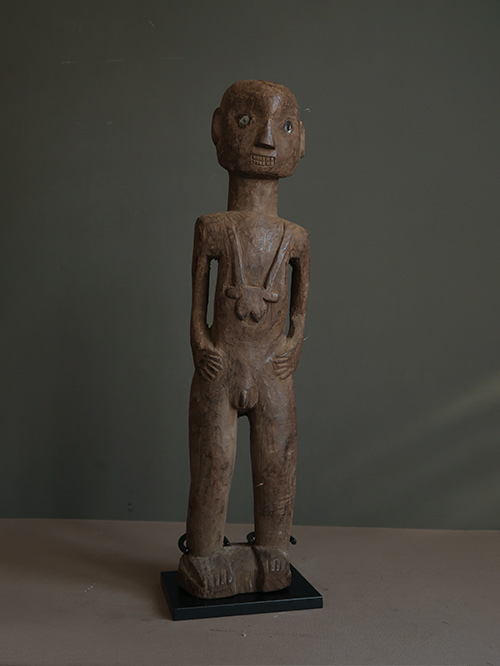
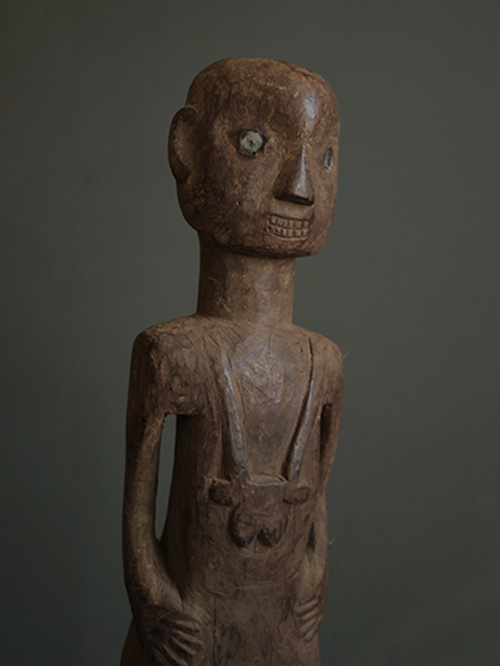
Nagaland (North-East India)
Wood and glass
A key fixture in nearly all Naga settlements was the Morung, or Men’s House, which served as something of a community center. It was usually the biggest and most beautifully furnished building in a village, spacious and decorated with ornate carvings. Numerous wooden sculptures decorated the walls and posts of the farthest end of the innermost space of the Morung. They expressed the narrative traditions of the Naga. Wooden sculpture such as this, depicting would be posted near the walls of the Morung, were not uncommon and thought to relate to fertility.
The Naga are a group of culturally and linguistically linked tribes who live in the mountainous regions of northeastern India and northwestern Burma (Myanmar). As headhunters, they were feared and avoided by their neighbours, allowing them to develop a distinctive material culture—in which objects they created are of impressive aesthetic value and possess great symbolic importance to the community—and a complex system of norms and taboos. The main tribal groups of the Naga include the Angami, Sema, Ao, Kalyo- Kengyu, Konyak, Lhota, Rengma, Tangkhul, Chang, Sangtam and Sema.
Size(cms): 53 (H) x 13 (W) x 8 (D)
Size(inches): 20.9 (H) x 5.1 (W) x 3.1 (D)
-
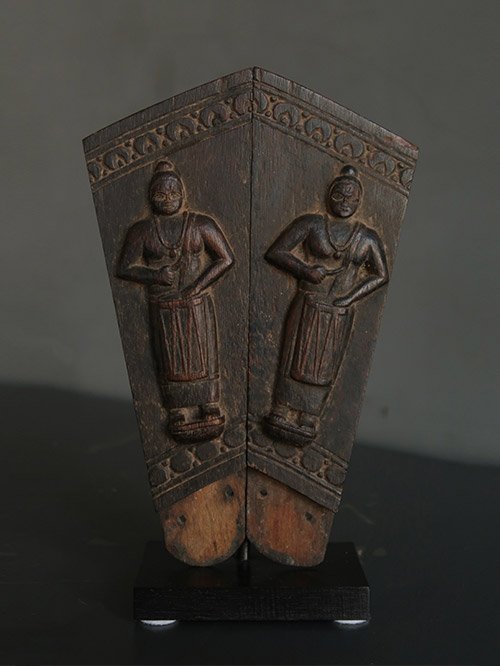
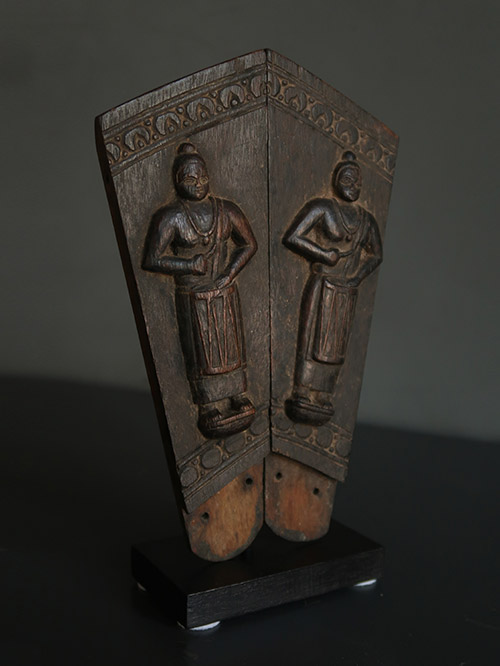
Northern Kerala (South India)
Wood
A fine pair of wedge shaped panels depicting a pair of musicians. Carved in low relief, the bare chested musicians wear dhotis and a simple necklace and have their hair tied up into buns. Conspicuously drawn on their foreheads are namams which are identification marks of Sri Vaishnavites. Their faces are locked in concentration as they play the chanda (cylindrical drum) that is strung over their shoulders. A band of geometric patterns frames the top and bottom of the panels.
Wedged shaped panels such as these would have been loosely strung together to form a ritual headpiece that would have been worn by the chief performer in ceremonial dances associated with temple festivals. The headpiece is boldly conceived , with a central figure of Gaja Laxmi, carved in high relief, seated on a lotus being lustrated by two elephants flanking her. Ten processional figures of musicians and attendants carrying staffs, drums, cymbals, trumpets etc. would have been depicted in low-relief on either side of the central motif.
Size(cms): 26 (H) x 15 (W) x 7 (D)
Size(inches): 10.2 (H) x 5.9 (W) x 2.7 (D)
-
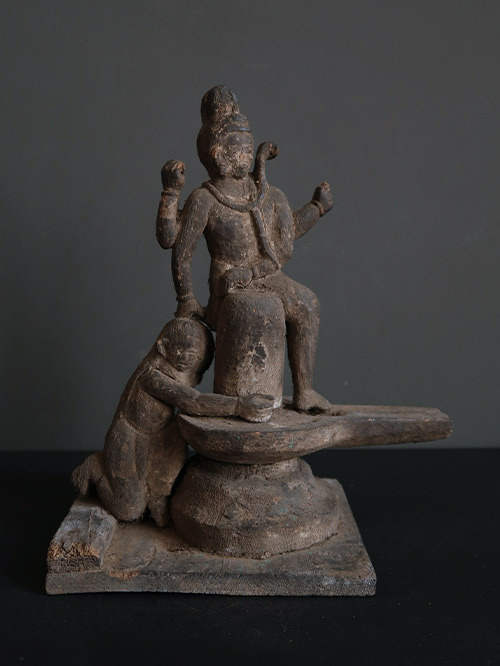

South India
Wood
An unusual group of figures depicting Markandeya embraces a linga. Four-armed Shiva is depicted emerging from the linga, splitting it apart, and with his right foot resting on the yoni. This incident is believed to have happened at Triprangode, Kerala where Lord Shiva appears and kills Yama when the latter appears to take the life of Markandeya who is one of Shiva’s ardent devotees.
Size (cms): 28 (H) x 23 (W) x 16 (D)
Size (inches): 11 (H) x 9 (W) x 6.3 (D)
-
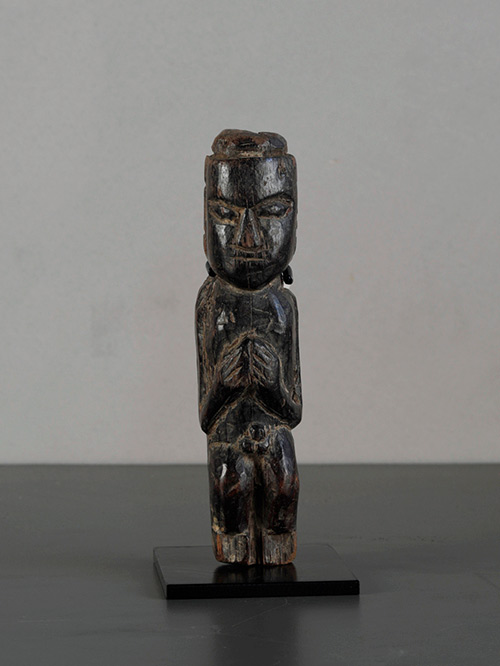
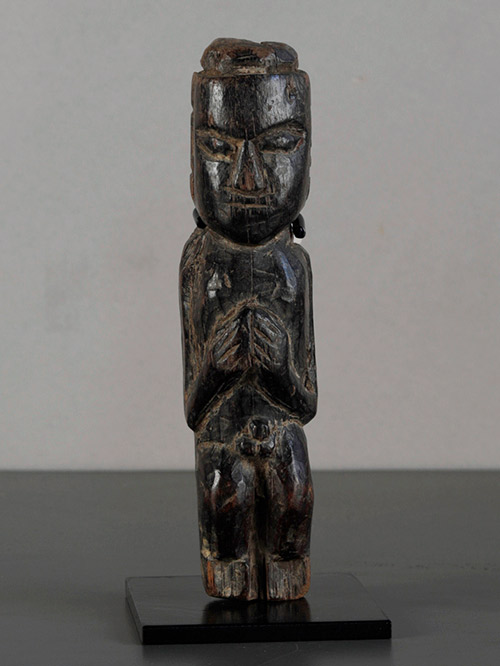
Maharashtra
Wood
A beautiful votive doll with its hands pressed in anjali mudra, a gesture of greeting and prayer. These small figures carved in wood, usually representing worshipping women, but also female water carriers, mothers, or pregnant women are simple in design, yet it is this implied simplicity that makes these figures attractive. They take various forms, triangular, rectangular, round or stepped. Often only the front of the sculptures are carved whereas the rears maybe left untreated. Often statuettes miss a nose, ears or arms. Many of the faces have been worn down from use, to a point where they reveal no detail.
These small figures were used for devotional purposes within the home, placed there as votive offerings to the Goddess Maulli/Mariai. Mauli is a powerful folk deity that protects against illness such as smallpox and cholera. But at the same time, neglecting her inflicts her wrath. She also takes the role of a fertility goddess to whom childless women seek respite. Figures of the Goddess are worshipped with turmeric, some red kunkum and oil which is daubed on her forehead.
Size (cms): 18(H) x 8(W) x 8(D)
Size (inches): 7(H) x 3(W) x 3(D)
-
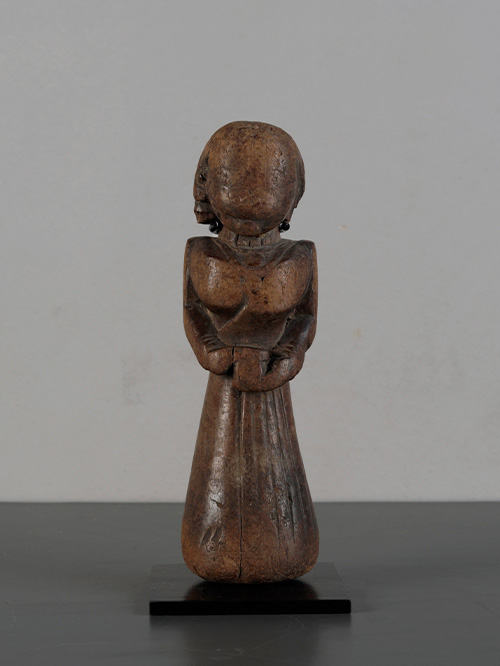
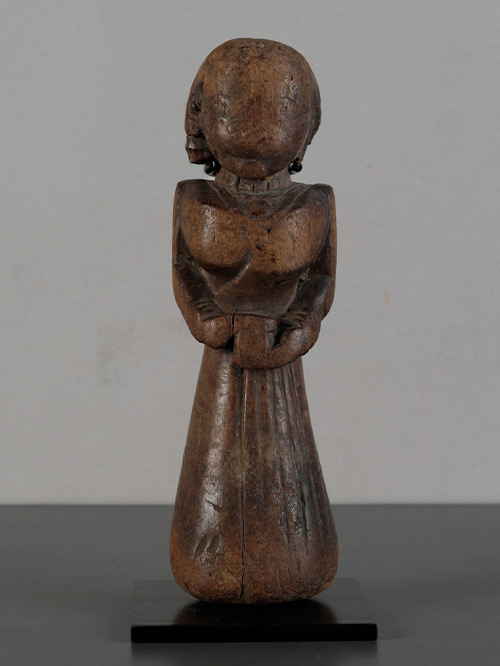
Maharashtra
Wood
A patinated votive doll with its hands pressed in anjali mudra, a gesture of greeting and prayer. These small figures carved in wood, usually representing worshipping women, but also female water carriers, mothers, or pregnant women are simple in design, yet it is this implied simplicity that makes these figures attractive. They take various forms, triangular, rectangular, round or stepped. Often only the front of the sculptures are carved whereas the rears maybe left untreated. Often statuettes miss a nose, ears or arms. Many of the faces have been worn down from use, to a point where they reveal no detail.
These small figures were used for devotional purposes within the home, placed there as votive offerings to the Goddess Maulli/Mariai. Mauli is a powerful folk deity that protects against illness such as smallpox and cholera. But at the same time, neglecting her inflicts her wrath. She also takes the role of a fertility goddess to whom childless women seek respite. Figures of the Goddess are worshipped with turmeric, some red kunkum and oil which is daubed on her forehead.
Size (cms): 22.5(H) x 9(W) x 9(D)
Size (inches): 9(H) x 3.5(W) x 3.5(D)
-
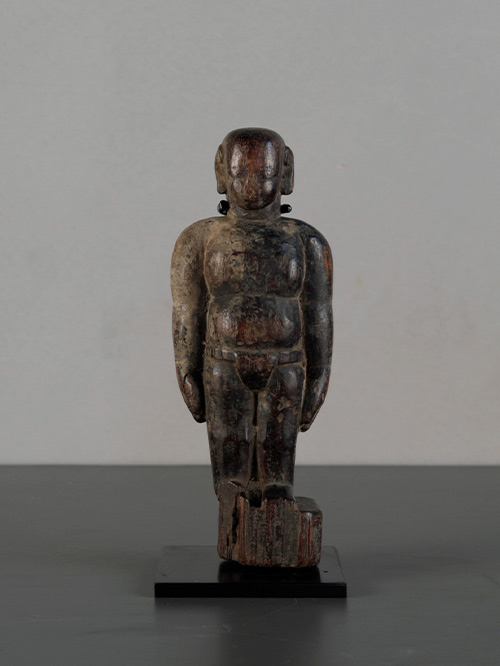
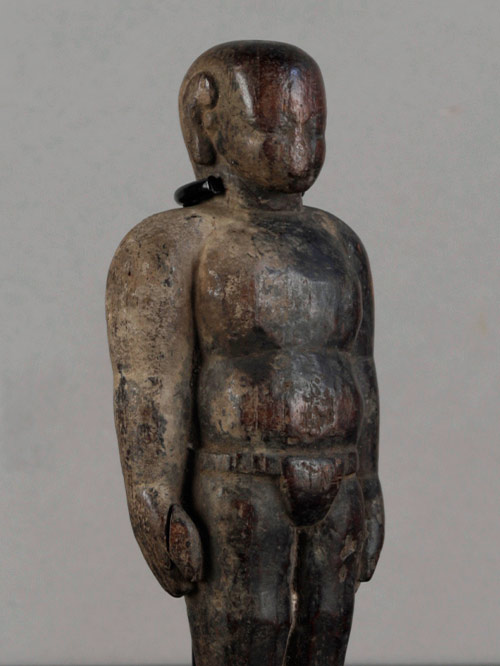
Maharashtra
Wood
An unusual wooden doll depicting a portly man standing at attention.
These small figures carved in wood, usually representing worshipping women, but also female water carriers, mothers, or pregnant women are simple in design, yet it is this implied simplicity that makes these figures attractive. They take various forms, triangular, rectangular, round or stepped. Often only the front of the sculptures are carved whereas the rears maybe left untreated. Often statuettes miss a nose, ears or arms. Many of the faces have been worn down from use, to a point where they reveal no detail.
These small figures were used for devotional purposes within the home, placed there as votive offerings to the Goddess Maulli/Mariai. Mauli is a powerful folk deity that protects against illness such as smallpox and cholera. But at the same time, neglecting her inflicts her wrath. She also takes the role of a fertility goddess to whom childless women seek respite. Figures of the Goddess are worshipped with turmeric, some red kunkum and oil which is daubed on her forehead.
Size (cms): 19(H) x 8(W) x 8(D)
Size (inches): 7.5(H) x 3(W) x 3(D)
-
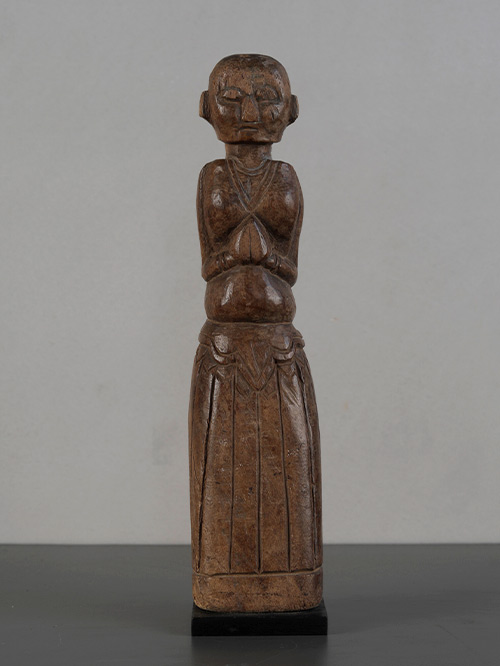
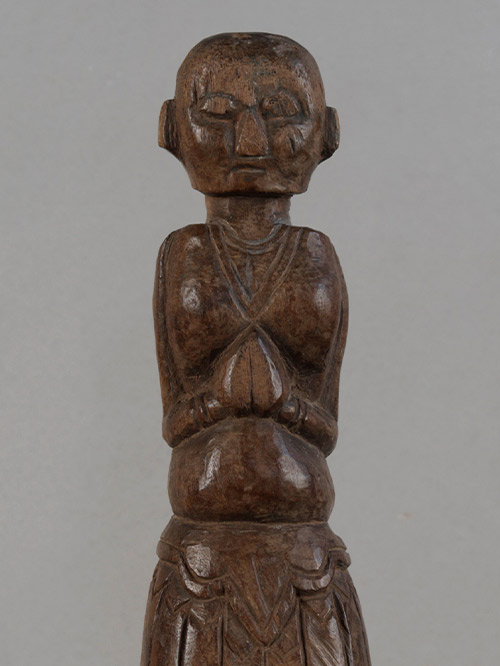
Maharashtra
Wood
A beautiful votive doll with its hands pressed in anjali mudra, a gesture of greeting and prayer. These small figures carved in wood, usually representing worshipping women, but also female water carriers, mothers, or pregnant women are simple in design, yet it is this implied simplicity that makes these figures attractive. They take various forms, triangular, rectangular, round or stepped. Often only the front of the sculptures are carved whereas the rears maybe left untreated. Often statuettes miss a nose, ears or arms. Many of the faces have been worn down from use, to a point where they reveal no detail.
These small figures were used for devotional purposes within the home, placed there as votive offerings to the Goddess Maulli/Mariai. Mauli is a powerful folk deity that protects against illness such as smallpox and cholera. But at the same time, neglecting her inflicts her wrath. She also takes the role of a fertility goddess to whom childless women seek respite. Figures of the Goddess are worshipped with turmeric, some red kunkum and oil which is daubed on her forehead.
Size (cms): 32(H) x 7.5(W) x 7(D)
Size (inches): 12.5(H) x 3(W) x 3(D)
-
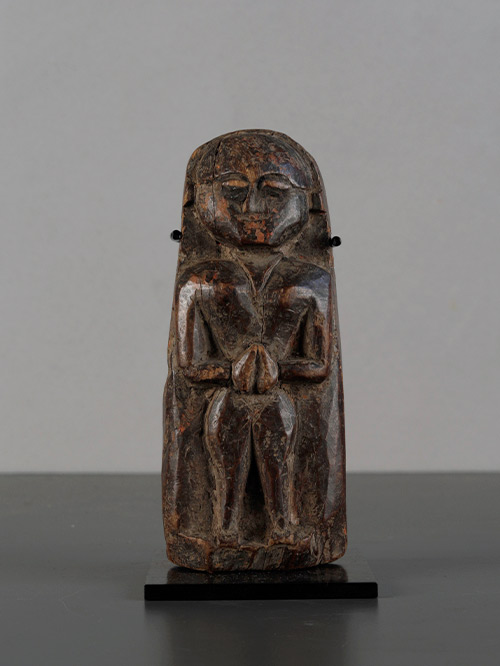
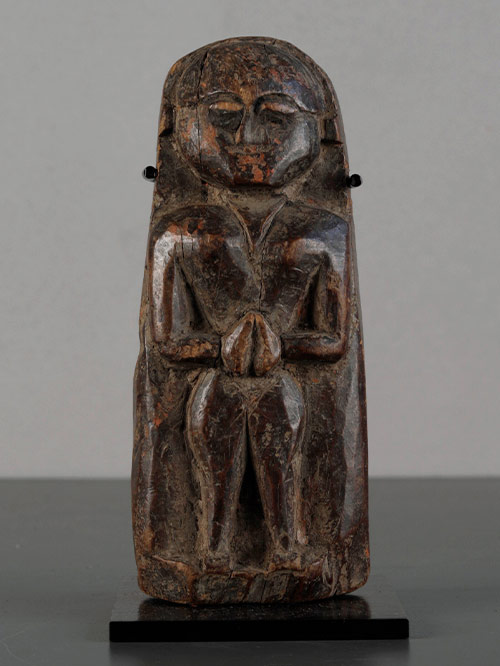
Maharashtra
Wood
A beautiful votive doll with its hands pressed in anjali mudra, a gesture of greeting and prayer. These small figures carved in wood, usually representing worshipping women, but also female water carriers, mothers, or pregnant women are simple in design, yet it is this implied simplicity that makes these figures attractive. They take various forms, triangular, rectangular, round or stepped. Often only the front of the sculptures are carved whereas the rears maybe left untreated. Often statuettes miss a nose, ears or arms. Many of the faces have been worn down from use, to a point where they reveal no detail.
These small figures were used for devotional purposes within the home, placed there as votive offerings to the Goddess Maulli/Mariai. Mauli is a powerful folk deity that protects against illness such as smallpox and cholera. But at the same time, neglecting her inflicts her wrath. She also takes the role of a fertility goddess to whom childless women seek respite. Figures of the Goddess are worshipped with turmeric, some red kunkum and oil which is daubed on her forehead.
Size (cms): 17.5(H) x 9(W) x 9(D)
Size (inches): 7(H) x 3.5(W) x 3.5(D)
-
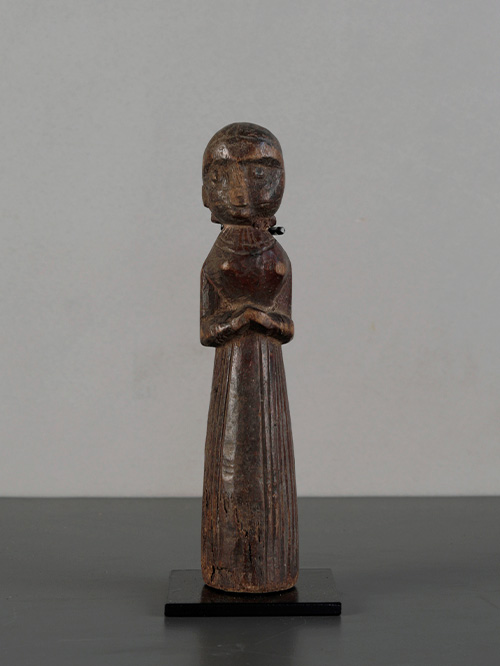
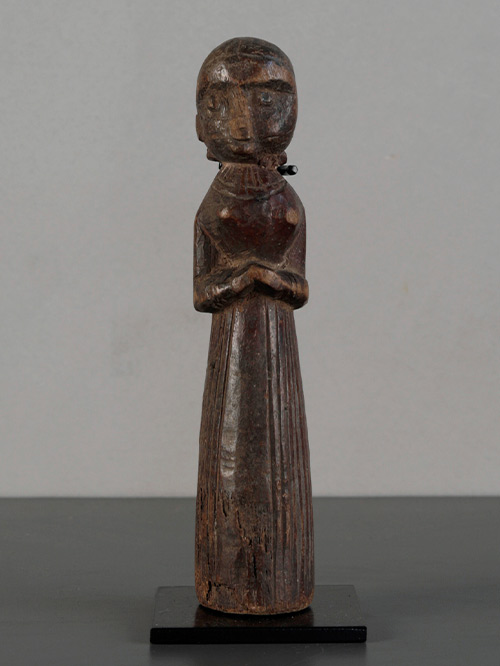
Maharashtra
Wood
A beautiful votive doll with its hands pressed in anjali mudra, a gesture of greeting and prayer. These small figures carved in wood, usually representing worshipping women, but also female water carriers, mothers, or pregnant women are simple in design, yet it is this implied simplicity that makes these figures attractive. They take various forms, triangular, rectangular, round or stepped. Often only the front of the sculptures are carved whereas the rears maybe left untreated. Often statuettes miss a nose, ears or arms. Many of the faces have been worn down from use, to a point where they reveal no detail.
These small figures were used for devotional purposes within the home, placed there as votive offerings to the Goddess Maulli/Mariai. Mauli is a powerful folk deity that protects against illness such as smallpox and cholera. But at the same time, neglecting her inflicts her wrath. She also takes the role of a fertility goddess to whom childless women seek respite. Figures of the Goddess are worshipped with turmeric, some red kunkum and oil which is daubed on her forehead.
Size (cms): 22(H) x 7.5(W) x 7.5(D)
Size (inches): 8.5(H) x 3(W) x 3(D)
-
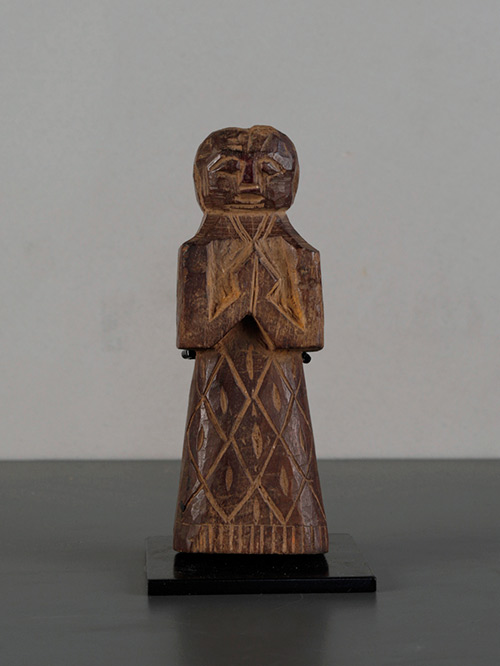
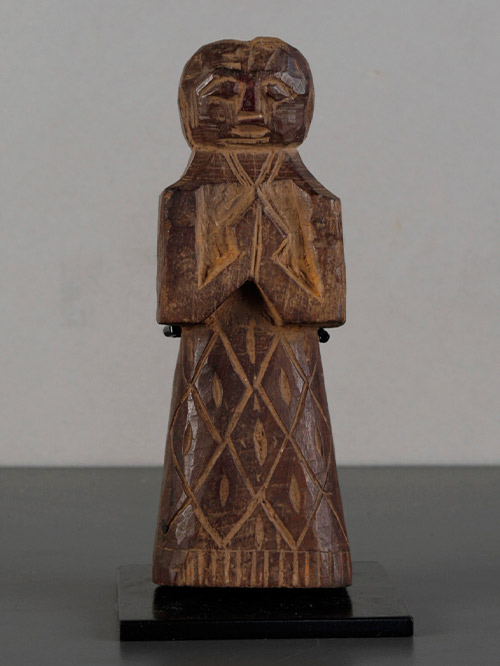
Maharashtra
Wood
A beautiful votive doll with its hands pressed in anjali mudra, a gesture of greeting and prayer. These small figures carved in wood, usually representing worshipping women, but also female water carriers, mothers, or pregnant women are simple in design, yet it is this implied simplicity that makes these figures attractive. They take various forms, triangular, rectangular, round or stepped. Often only the front of the sculptures are carved whereas the rears maybe left untreated. Often statuettes miss a nose, ears or arms. Many of the faces have been worn down from use, to a point where they reveal no detail.
These small figures were used for devotional purposes within the home, placed there as votive offerings to the Goddess Maulli/Mariai. Mauli is a powerful folk deity that protects against illness such as smallpox and cholera. But at the same time, neglecting her inflicts her wrath. She also takes the role of a fertility goddess to whom childless women seek respite. Figures of the Goddess are worshipped with turmeric, some red kunkum and oil which is daubed on her forehead.
Size (cms): 18.5(H) x 9(W) x 9(D)
Size (inches): 7.5(H) x 3.5(W) x 3.5(D)
-
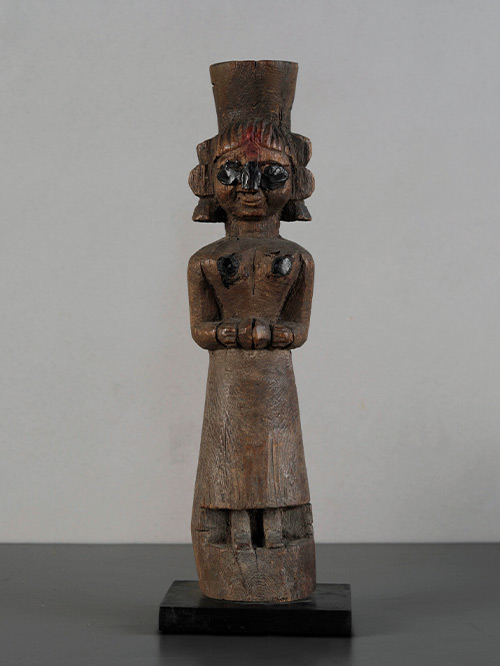

Maharashtra
Wood
A beautiful votive doll with its hands pressed in anjali mudra, a gesture of greeting and prayer. These small figures carved in wood, usually representing worshipping women, but also female water carriers, mothers, or pregnant women are simple in design, yet it is this implied simplicity that makes these figures attractive. They take various forms, triangular, rectangular, round or stepped. Often only the front of the sculptures are carved whereas the rears maybe left untreated. Often statuettes miss a nose, ears or arms. Many of the faces have been worn down from use, to a point where they reveal no detail.
These small figures were used for devotional purposes within the home, placed there as votive offerings to the Goddess Maulli/Mariai. Mauli is a powerful folk deity that protects against illness such as smallpox and cholera. But at the same time, neglecting her inflicts her wrath. She also takes the role of a fertility goddess to whom childless women seek respite. Figures of the Goddess are worshipped with turmeric, some red kunkum and oil which is daubed on her forehead.
Size (cms): 31.5(H) x 10.5(W) x 8(D)
Size (inches): 12.5(H) x 4(W) x 3(D)
-
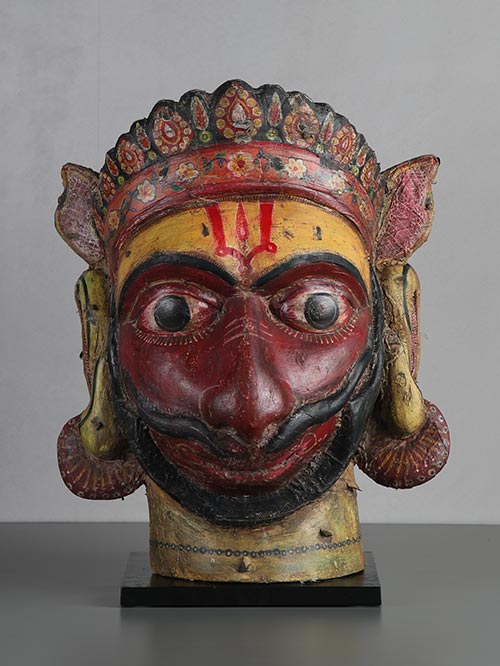
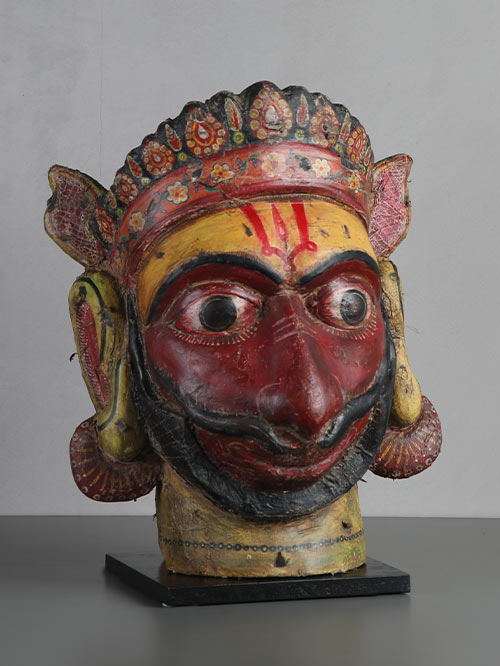
Orissa (Eastern India)
Wood, extensively polychromed
A magnificent and rare processional head in good condition with original colour and patina
Hanuman is a popular deity who is worshipped all over India, particularly in villages and in the South. His story is found in the Ramayana where he is the ubiquitous servant of Rama, the epitome of devoted service and loyalty. His search for the heroine Sita, captured by Ravana, illustrates his superhuman powers and zealous performance of the tasks that were given to him.
Shahi Jatras (royal processions) of Orissa present different episodes from the Ramayana during the spring season, usually lasting for for one week. Actors, carrying huge wooden masks and gorgeous costumes, walk on the streets with stylized gait and mime with the accompaniment of loud drumming. The Desia Nata of Koraput, Orissa, also uses masks for representing gods, goddesses, animals, birds and demons. These themes are also taken from Ramayana.
Size (cms): 56(H) x 46(W) x 43(D)
Size (inches): 22(H) x 18(W) x 17(D)
-
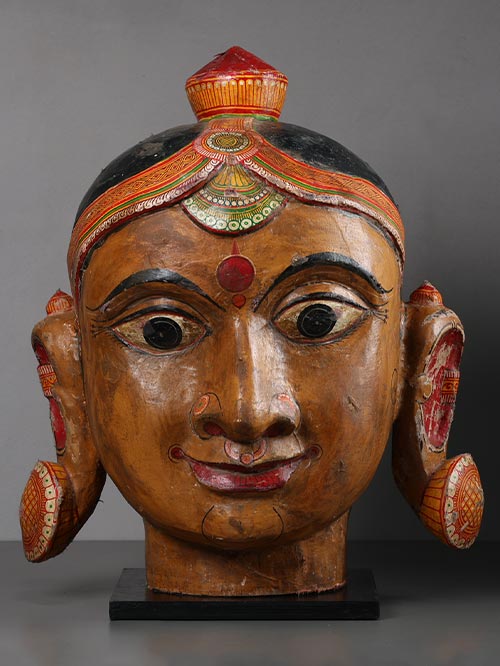

Orissa (Eastern India)
Wood, extensively polychromed
A magnificent and rare processional head in good condition with original colour and patina
Sita, is the central female character of the Hindu epic Ramayana and a daughter of King Janak of Janakpur. She is the consort of the Hindu god Rama (avatar of Vishnu) and is an avatar of Lakshmi (Aadi Shakti of Lord Vishnu), goddess of wealth and wife of Vishnu. She is esteemed as a paragon of spousal and feminine virtues for all Hindu women. Sita is known for her dedication, self-sacrifice, courage and purity.
Shahi Jatras (royal processions) of Orissa present different episodes from the Ramayana during the spring season, usually lasting for for one week. Actors, carrying huge wooden masks and gorgeous costumes, walk on the streets with stylized gait and mime with the accompaniment of loud drumming. The Desia Nata of Koraput, Orissa, also uses masks for representing gods, goddesses, animals, birds and demons. These themes are also taken from Ramayana.
Size (cms): 61(H) x 50(W) x 48(D)
Size (inches): 24(H) x 19.5(W) x 19(D)
-


Orissa (Eastern India)
Wood, extensively polychromed
A beautiful large polychromed wooden head of a Tiger painted yellow with large white and black bubris (stripes) and a characteristic candy cane moustache. In typical Orissan style, the tiger has large geometric earrings and a decorated tiered crown.
Shahi Jatras (royal processions) of Orissa present different episodes from the Ramayana during the spring season, usually lasting for for one week. Actors, carrying huge wooden masks and gorgeous costumes, walk on the streets with stylized gait and mime with the accompaniment of loud drumming. The Desia Nata of Koraput, Orissa, also uses masks for representing gods, goddesses, animals, birds and demons. These themes are also taken from Ramayana.
Size (cms): 76(H) x 56(W) x 47(D)
Size (inches): 30(H) x 22(W) x 18.5(D)
-

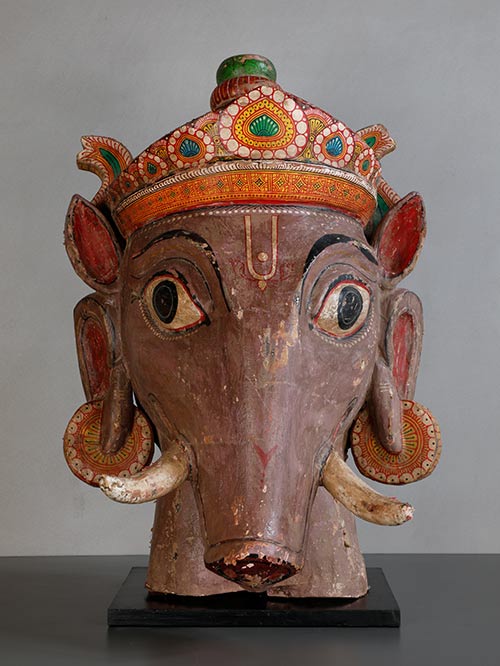
Orissa (Eastern India)
Wood, extensively polychromed
A magnificent and rare processional head in good condition with original colour and patina. Varaha is the third avatar of Lord Vishnu. He is usually depicted as half-human and half-boar, slaying the asura Hiranyaksha and carrying a conch shell, a discus, a mace, and a lotus flower in his four hands. He is considered to be the saviour of the world and the protector of the earth and his worship is believed to bring prosperity and good fortune.
Shahi Jatras (royal processions) of Orissa present different episodes from the Ramayana during the spring season, usually lasting for for one week. Actors, carrying huge wooden masks and gorgeous costumes, walk on the streets with stylized gait and mime with the accompaniment of loud drumming. The Desia Nata of Koraput, Orissa, also uses masks for representing gods, goddesses, animals, birds and demons. These themes are also taken from Ramayana.
Size (cms): 75.5(H) x 59(W) x 56(D)
Size (inches): 29.5(H) x 23(W) x 22(D)
-
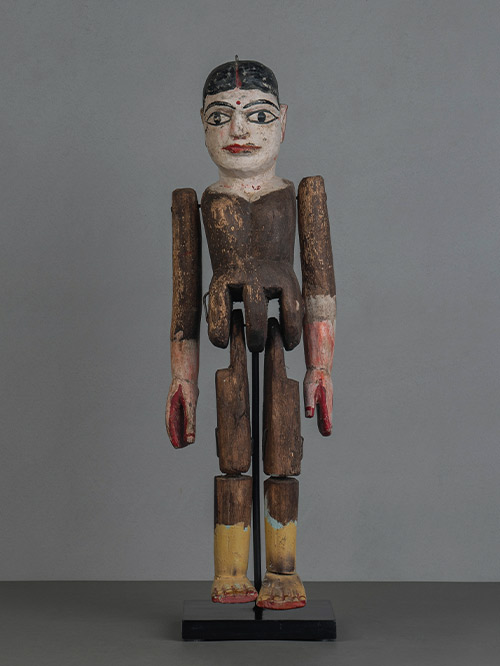
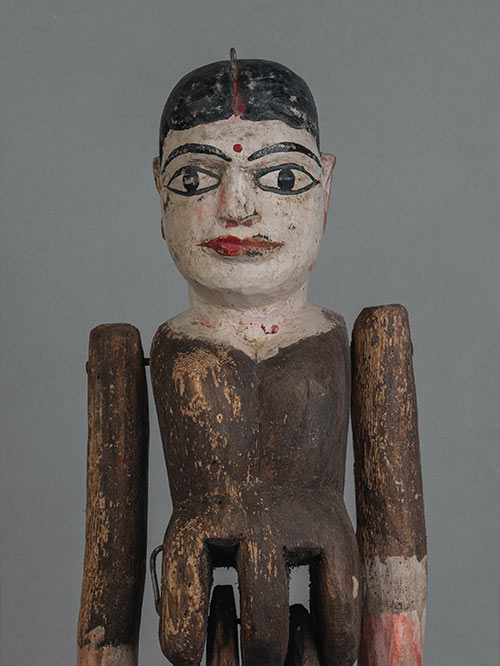
Orissa
Wood with traces of polychroming
An articulated wooden puppet from Orissa in the style of Kundhei. This art is performed by puppeteers in groups that travel from village to village performing shows. Kundhei is considered as a dying art form as performers turn to more sustainable forms of income. The costumes of Kundhei resemble those worn by actors of the Jatra traditional theatre.
Puppetry in India can be traced back as early as the Indus Valley civilisation, and has always had a vibrant and ancient tradition of using string puppets or marionettes. String puppets were traditionally made of wood, or wire, or cloth stuffed with cotton, rags or saw dust. Themes for puppet theatre are mostly based on epics like the Ramayana and Mahabharata but also include local myths and legends. Puppetry is popular in various state, and each state has slightly varies styles and themes.
Size (cms): 60(H) x 17(W) x 15(D)
Size (inches): 23.5(H) x 6.5(W) x 6(D)

































